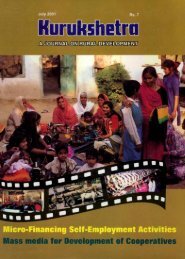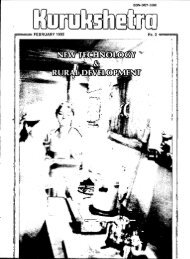Banking - Yojana
Banking - Yojana
Banking - Yojana
- TAGS
- banking
- yojana
- yojana.gov.in
You also want an ePaper? Increase the reach of your titles
YUMPU automatically turns print PDFs into web optimized ePapers that Google loves.
Generated by PDFKit.NET Evaluation<br />
•<br />
•<br />
New Health Policy Focuses on<br />
PriDlary Sector<br />
THE NATIONAL Health<br />
Policy, announced<br />
. recently aims at reviving<br />
the ailing health system and<br />
increasing the primary health<br />
seCtor outlay to ensure a more<br />
equitable access to health services<br />
across the social and geographical<br />
expanse of the country.<br />
The government plans to<br />
increase its contribution to the<br />
health sector from 0.9 per cent of<br />
the GDP at present to 2 per cent<br />
over the next eight years. By 2010,<br />
the policy envisages an increase in<br />
aggregate expendi ture on the<br />
health sector from 5.2 per cent to 6<br />
per cent. It has also been<br />
recommended to the states to<br />
increase expenditure from 5.5 per<br />
cent to 7 per cent of their budget<br />
by 2005 and further to 8 per cent<br />
by 2010. '<br />
According to NHP, 55 per cent<br />
of the outlay would be for the<br />
primary sector and 35 per cen t and<br />
10 per cent for the secondary and<br />
tertiary sectors respectively.<br />
While releasing the revised<br />
health policy, Union Health and<br />
Family Welfare Minister Dr C P<br />
Sushma Chandra<br />
Prices of various essential drugs and formulations<br />
have gone up. This becomes the biggest challenge for<br />
the successful implementation of the new health policy,<br />
which the health authorities 'in the country should<br />
be paying more attention to in the coming years.<br />
Ms. Sushma Chandra is a freelance journalist.<br />
Thakur, said the last policy was<br />
formulated in 1983 and since then<br />
the health scene has changed<br />
dramatically requiring a more<br />
exhaustive approach. So the policy<br />
envisages the setting up of an<br />
organized urban primary health<br />
structure to meet increased needs.<br />
It suggests a two-tiered structure,<br />
with the primary health centre<br />
providing the first tier and a second<br />
tier of a government general<br />
hospital.<br />
For improvement of the public<br />
health infrastructure it suggessts<br />
reyival of the primary health system<br />
by providing essential drugs; levying<br />
of user charges for certain<br />
secondary and tertiary public<br />
health care services for those who<br />
can afford to pay, expanding the<br />
pool of medical practitioners and<br />
simplification of the recruitment<br />
procedures for contract<br />
employment.<br />
For funding and upgrading<br />
existing government medical and<br />
dental colleges, it has suggested<br />
setting up of a Medical Grants<br />
Commission. Even the curriculum<br />
should be modified to make it more<br />
need-b~sed, the policy has stressed.<br />
It has also suggested specialization<br />
in public health, which has been. a<br />
neglected area, both for medical<br />
doctors and non-medical graduates<br />
from allied fields.<br />
To boost medical research, it has<br />
suggested that government-funded<br />
medical research be increased to a<br />
level of one per cent of the total<br />
health spending by 2005 and up to<br />
2 per cent by 2010 .. It laments the<br />
fact that in our country, where the<br />
aggregate annual health<br />
expenditure is of the order of<br />
Rs. 80,000 crore, the expenditure<br />
in 1998-99 on research, both public<br />
and private sectors, was only<br />
Rs. 1,150 crore. It would be<br />
reasonable to infer that with such<br />
low research expenditure, it is<br />
virtually impossible to make any<br />
dramatic break-through within the<br />
country, by way of new molecules<br />
and vaccines; also without a<br />
minimal back-up of applied and<br />
operational research, it would be<br />
difficult to assess whether the<br />
health expenditure in the country<br />
is being incurred through optimal<br />
applications and appropriate<br />
public health strategies.<br />
YOJANAJuly 2002 25<br />
Click here to unlock PDFKit.NET






